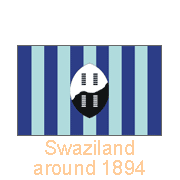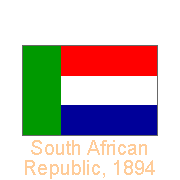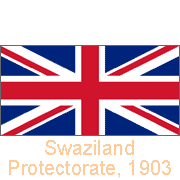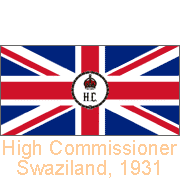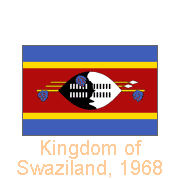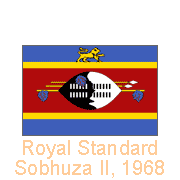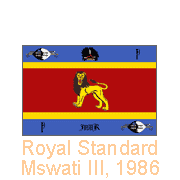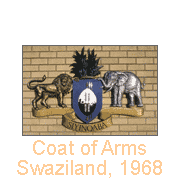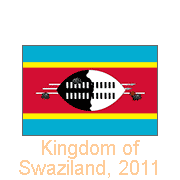Flags from Swaziland

A Flag history of eSwatini - Swaziland
In the mid-1800s the Swazi people under their King Mswati I, were in constant conflict with the numerically stronger Zulu people to their south and realising he could not defeat them, sought protection from the British; although initially refused, the British government signed a convention recognising Swazi independence in 1881 but then white settlers came into the country and land and mineral rights concessions were made over the heads of the Swazis in 1890.
you may then send it as a postcard if you wish.
Theophilus Shepstone, a British South African statesman who was responsible for the annexation of the Transvaal to Britain in 1877, was adviser to the Swazis from 1887 to 1891. Swaziland was ruled by a Triumvirate Government, made up of Swazi, Boer and British People; Theophilus Shepstone represented Swaziland. In 1894 a distinct Swazi flag was flown, with eleven alternating equal dark and light blue stripes and a Swazi shield, also placed vertically, in the centre. The flag is a bit of a mystery and there seems to have been another version, vertically divided into a dark and a light blue field with a vertical shield in the centre and two crossed battle axes in the top hoist. It is all speculative as no actual copies of either flag survives.
Under an agreement signed in 1894 by Britain and South Africa, the Swazi were handed over to Paul Kruger's South African Republic (Transvaal), against their wishes and accordingly the Transvaal "vierkleur" was flown until 1902. After the Anglo-Boer War of 1899-1902 and the defeat of this ZAR (Zuid Afrikaansche Republiek), the British government placed Swaziland in 1903 under its direct jurisdiction as a Protectorate. Because the protectorate did not have a distinctive flag of its own, the Union Jack was flown until independence in October 1968.
The Protectorate was administered through the Office of the High Commissioner in South Africa, which was created in 1878. The High Commissioner in and for South Africa flew a British Union Flag charged in the centre, on a white roundel, with the letters S.A.H.C. in black above a Tudor Crown, within a green garland of laurel. This flag, which came into use in 1907, was used until 1931 after which the posts of Governor-General (of South Africa) and High Commissioner were separated. In 1931 the post of High Commissioner of Basutoland, Bechuanaland and Swaziland was created, responsible for the administration of the three British Protectorates in southern Africa. The High Commissioner, based in South Africa, was represented by a Resident Commissioner in each of the High Commission Territories; he flew a British Union Flag charged in the centre, on a white roundel, the letters H.C. in black, above the Imperial State Crown, within a garland of green laurel.
A year before independence from Britain, Swaziland's flag was officially hoisted on 30 October 1967. It was based on the flag, granted by King Sobhuza II in 1941 to the Emasotsha Regiment of the Swazi Pioneer Corps, which had fought on behalf of the Allies during World War II. This flag, amended slightly, was hoisted on 25 April 1967 when the British Union flag, used during the colonial period, was hauled down. The crimson colour is the symbol of past struggles; yellow points at prosperity by the richness in minerals; blue is the colour of peace. A Swazi oxhide-shield, belonging to the Emasotsha regiment, is laid sideways on the central stripe as if carried while walking. Decorative "injobo", bunches of feathers of the lisakabuli (widowbird) and ligwalagwala (purple-crested lourie), hang from the black portion of the shield. The shield is reinforced by a staff from which also hang injobo tassels, bunches of feathers of the widowbird and the lourie. Two spears, symbolising protection of the country, are placed above the staff. Swaziland became fully independent on 6 September 1968.
King Sobhuza II, who reigned Swaziland from 1921 to his death in 1982, used as a Royal Standard the National Flag with a small gold lion on the upper stripe. It was designed by King Sobhuza himself; the lion is the symbol of the king. The Royal Standard flew publicly for the first time on 5 September 1968 at the Somhlolo National Stadium at Lobamba during the independence celebrations. Sobhuza II was succeeded by his son Makhosetive, who took the title of Mswati III in 1986 and adopted a new Royal standard: The lion symbol became the most prominent feature on the flag, on the central maroon stripe, orientated to the hoist and facing the observer. Small shields of the Emasotsha Regiment (lihawu) and traditional Swazi battle axes (lizeze) are placed on the blue stripes. The "Inyoni", the king's ceremonial feather head-dress is placed in the centre of the upper stripe and the royal cipher (M III R) is in the centre of the lower stripe.
Swaziland's coat of arms depicts various symbols in traditional Swaziland culture. The two supporters are the symbols of power for the "Ngwenyama", the King (lion) and the "Ndlovukati", the Queen-mother (she-elephant). These support a traditional Nguni shield of the Emasotsha Regiment, resting on two spears, representing "protection". Above the shield is the king's "lidlabe", a crown of feathers, normally worn during iNcwala (the festival of the harvest). On a banner below the shield is the Swaziland national motto, Siyinqaba, meaning, "We are the fortress"; this may also be interpreted as "We are a tower of strength".
In July 2011, the flag of Swaziland slightly changed, without an official announcement. The shade of blue changed to a lighter colour, and the spears and shaft, now with a brown guard, were white. The “injobo”, bunches of feathers, were now in grey in a more realistic rendition.


